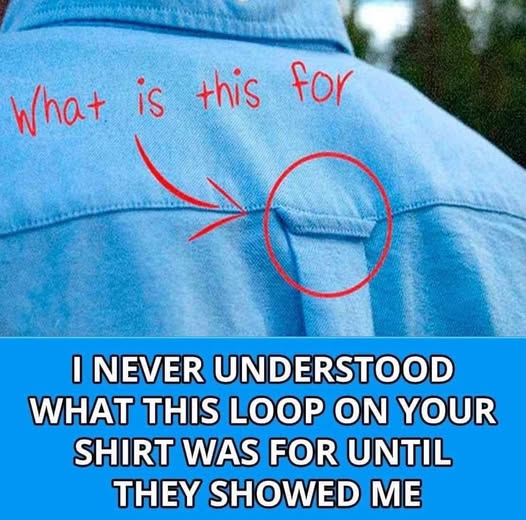ADVERTISEMENT
**I Never Understood What This Loop On Your Shirt Was For Until They Showed Me**
If you’ve ever bought a new shirt and noticed a small, seemingly pointless loop sewn onto the inside of the collar or back, you’ve probably wondered, “What’s the point of this thing?” Well, it turns out that this little feature isn’t just for decoration or some random design quirk—it has a very practical purpose.
In this article, we’re going to explore the mystery behind the loop on your shirt and why it’s there. Whether you’ve seen it on dress shirts, casual shirts, or jackets, this loop has an interesting backstory that might just change the way you look at your clothes forever.
### What is This Loop on My Shirt?
The loop sewn into the back of many shirts, especially dress shirts, is commonly referred to as a **locker loop** or **hanger loop**. It’s typically a small piece of fabric, often located at the nape of the neck or center of the back, that serves a very specific function.
At first glance, it may look like a random extra piece of fabric or a design feature, but it’s actually a **functional** detail with a long history. Here’s the catch—this small loop was actually designed for hanging your shirt or jacket in a locker. Sounds a little odd, right? But let’s take a deeper dive into its purpose.
### The History of the Locker Loop
The **locker loop** dates back to the early 20th century when clothing manufacturers began making shirts with higher quality and more durable materials. These shirts were often worn by **men working in office environments** or at **schools** where people would hang their clothes in a locker or on a hook while changing.
In the days before dry cleaning, **clothing was often hung in lockers or public spaces to air out**, and the loop was designed to allow people to hang their shirt or jacket by the neck. This was particularly common in **military uniforms**, **workwear**, and **school uniforms**, where practicality and durability were key. It was a simple way to keep clothes wrinkle-free while avoiding the hassle of folding them or draping them over a hook.
### Why is It Still on Shirts Today?
Despite modern-day conveniences like coat hangers, closets, and hangers, the **locker loop** has remained a fixture on many shirts to this day. While the use of lockers and coat hooks has dwindled in daily life, the loop still carries with it a sense of **tradition** and **nostalgia**.
Plus, for many shirt manufacturers, the locker loop has evolved into a **symbol of craftsmanship**. It’s a little detail that sets certain brands apart, and some high-end designers still include this feature for aesthetic purposes or to maintain a classic look.
The loop is also a **functional addition** for those who like to hang their shirt in a closet or locker while keeping it crisp and ready to wear. In fact, many people continue to use the loop today for **easy storage** and to keep their shirts in a wrinkle-free position when they don’t have the luxury of a hanger.
### How to Use the Loop on Your Shirt
So, now that you know what this loop is, you might be wondering how exactly to use it. Here are a few ideas:
1. **Hanging Your Shirt**: You can use the loop to **hang your shirt directly** on a hook or locker. This is especially useful if you’re trying to keep it free from wrinkles or you don’t have access to a proper hanger.
2. **Avoiding Wrinkles**: If you’re traveling or at the gym, you can use the loop to hang your shirt on a hook or in your locker. This way, your shirt stays smooth and fresh before you need to wear it again.
3. **Temporary Hanger Substitute**: If you’re in a pinch and can’t find a coat hanger, you can hang your shirt by the loop from a doorknob, hook, or rail. It’s not a perfect solution, but it does the job in a quick, easy way.
4. **Aesthetic or Decorative Purpose**: In some cases, the loop is purely for **aesthetic appeal**, giving the shirt a stylish or classic look. In this case, you may choose to simply leave it as a design feature and not use it for its intended purpose.
For Complete Cooking STEPS Please Head On Over To Next P
